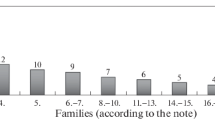Abstract
The residual failures of harmony between botanical and cultivated plant systematists is related to a review of their methodologies. Because some cultivated plant groups overlap the distinction, it is argued that special classification systems are not appropriate generally to cultivated plants. A fundamental reason for the difficulty is suggested and it is shown that this still allows, as a compromise solution, the adoption of the author's previously published flexible unified hierarchy of categories, which is figured and its relevance to the whole situation explained. Some misunderstandings between botanists and horticulturists are reviewed and explanations consistent with the previous discussion offered. These concern typification, whether cultivars require types or have synonyms and what should be done about the confusion of “typical”. The relationship between the Codes is clarified by an example and the matter of the “gardener's species” is discussed.
Similar content being viewed by others
References
Brickell, C. D., 1970:Euryops acraeus orEuryops evansii. — J. Roy. Hort. Soc.95: 94–95.
—, 1973: Problems of horticultural nomenclature. — InGreen, P. S., (Ed.): Plants: wild and cultivated, pp. 102–113. — Hampton: E. W. Classey.
—, (Ed.), 1980: International code of nomenclature for cultivated plants—1980. — Utrecht: Bohn, Scheltema & Holkema.
Burtt, B. L., 1970: Infraspecific categories in flowering plants. — Biol. J. Linn. Soc.2, 233–238.
Cowan, S. T., 1962: The microbial species—a macromyth?—InAinsworth, G. C., Sneath, P. H. A., (Eds.): Microbial classification, pp. 433–455. — Cambridge: Cambridge University Press.
Davis, P. H., Heywood, V. H., 1963: Principles of angiosperm taxonomy. — Edinburgh, London: Oliver & Boyd, repr. 1967.
Gilmour, J. S. L., 1940: Taxonomy and philosophy. — InHuxley, J., (Ed.): The new systematics, pp. 461–474. — Oxford: O.U.P. — Repr. 1971: London: The Systematics Association.
—, 1973: And never the twain shall meet: horticulture and botany—allies not enemies. — InGreen, P. S., (Ed.): Plants: wild and cultivated, pp. 13–17. — Hampton: E. W. Classey.
—, 1939: Demes: a suggested new terminology. — Nature144: 333–334.
Heywood, V. H., 1967: Variation in species concepts. — Regnum Veg.27: 26–37.
Ingram, J., 1969: Notes on cultivatedLiliaceae, 5.Hosta seboldii andHosta sieboldiana. — Baileya15: 27–32.
Lewis, J., 1986a: The classification of cultivars in relation to wild plants. — InStyles, B., (Ed.): Infraspecific classification of wild and cultivated plants. — Systematics Assoc. Spec. Vol.29: 115–137. — Oxford: Clarendon Press.
- 1986b: The classification of conifer cultivars. — Acta Horticulturae182 (in press).
Linnaeus, C., 1753: Species plantarum. — Stockholm.
Mettler, L. F., Gregg, T. G., 1969: Population genetics and evolution. — London: Prentice-Hall.
Parker, P. F., 1978: The classification of crop plants. — InStreet, H. E., (Ed.): Essays on plant taxonomy. — London: Academic Press.
Pickersgill, B., 1986: Evolution of hierarchical variation patterns under domestication and their taxonomic treatment. — InStyles, B., (Ed.): Infraspecific classification of wild and cultivated plants. — Systematics Assoc. Spec. Vol.29: 191–209. — Oxford: Clarendon Press.
Stace, C. A., 1986: The present and future infraspecific classification of wild plants. — InStyles, B., (Ed.): Infraspecific classification of wild and cultivated plants. — Systematics Assoc. Spec. Vol.29: 9–20. — Oxford: Clarendon Press.
Stearn, W. T., 1966:Viburnum farreri, a new name forV. fragrans Bunge. — Taxon15: 22–23.
—, 1973: The principles of botanical nomenclature, their basis and history. — InGreen, P. S., (Ed.): Plants wild and cultivated, pp. 86–111. — Hampton: E. W. Classey.
Voss, E. G., (Ed.) 1983: International code of botanical nomenclature. — Utrecht, Antwerp: Bohn, Scheltema & Holkema.
Welch, H. J., 1979: Manual of dwarf conifers. — New York: Theophrastus.
Author information
Authors and Affiliations
Additional information
Dedicated to the memory of JohnS. L. Gilmour.
Rights and permissions
About this article
Cite this article
Lewis, J. Botany and horticulture — the twain shall meet. Pl Syst Evol 167, 7–22 (1989). https://doi.org/10.1007/BF00936543
Received:
Issue Date:
DOI: https://doi.org/10.1007/BF00936543




